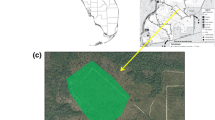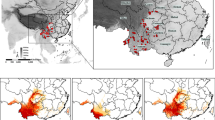Abstract
This study deals with the habitat requirements and (meta)population ecology of the Birdwing Butterfly Troides aeacus in the Xiaolongshan forest area and the Baishuijiang Natural Reserve of Gansu Province, China. The more descriptive components mainly summarize the biology and habitat requirements of the species. A detailed account is given of 3-year presence/absence dynamics in a suspected metapopulation, which consists of ten habitat patches. By means of GLM a habitat model was developed which has shown that the abundance of Troides aeacus will increase with both the number of larval host plants and adult nectar plants, while it will decrease with denser forest canopy structure. The hierarchical partitioning of the explained variance indicated that the independent effects of the number of nectar plants and the forest canopy density are the most important factors, while the explanatory power of the number of host plants was minimal. Habitat loss and degradation are the most severe threats to Troides aeacus populations in the study area. These are mainly due to continuous human activities such as destruction of forest for reclamation, grazing, mine exploitation, and cutting of firewood, but also herbicide application and sometimes even certain types of afforestation. While the availability of host plants is a clear pre-requisite for the survival of the species, conservation should be most efficient through an increase in the abundance of nectar plants as well as through the avoidance of complete forest cover (through an appropriate cutting management which would also promote growth of the host plants). As environmental threats are quite similar in the entire Southern Gansu region, we expect that the implementation of such butterfly conservation measures should have positive impacts on many other components of biodiversity.






Similar content being viewed by others
Notes
Within mark-release-recapture studies in Bifeng valley from June to July in 2002 and 2003 we captured a total of 75 Troides aeacus individuals (16 females and 59 males). Due to the low number of recaptures we could not make any population estimates. However, as we could capture many of the butterflies we have seen (females easier than males, thus much less females present than males), the study population can be assumed to be extremely small and surely below the population size often observed as MVP for butterflies (Schtickzelle and Baguette 2009).
References
An DG (2002) Xiaolong Mountain high plants flora of Gansu province (in Chinese). Race Publisher, Gansu
Bates D, Mechler M (2008) Linear mixed effects models using S4 classes, ver 0.999375-27. http://lme4.r-forge.r-project.org
Biodiversity Committee of Chinese Academy of Sciences (1994) Biodiversity studies series no. 1. Principles and methodologies of biodiversity studies. Chinese Scientific and Technological Press, Beijing
Boggs CL, Watt WB, Ehrlich PR (2003) Butterflies: ecology and evolution taking flight. University of Chicago Press, Chicago
Bolker BM, Brooks ME, Clark CJ, Geange SW, Poulsen JR, Stevens MHH, White JSS (2009) Generalized linear mixed models: a practical guide for ecology and evolution. Trends Ecol Evol 24:127–135
Cai YX, Liao ST, Wu FQ (2003) Manual breeding observation of Troides aeacus and Troides helena. Guangdong Agric Sci 5:51–53
Casula P, Nichols D (2003) Temporal variability of local abundance, sex ratio and activity in the Sardinian Chalk hill blue butterfly. Oecologia 136:374–382
Chou I (1994) Monographia Rhopalocerorum Sinensium. Henan Scientific and Technological Publishing House, Zhengzhou
Collins NM, Morris MG (1985) Threatened swallowtail butterflies of the world. The IUCN red data book. IUCN, Gland
D’Abrera B (1982) Butterflies of the oriental region part 1. Hill House, Victoria
Hanski I, Gilpin M (1997) Metapopulation biology. Academic Press, San Diego
Hanski I, Pakkala T, Kuussaari M, Lei GC (1995) Metapopulation persistence of an endangered butterfly in a fragmented landscape. Oikos 72:21–28
Huang GD, Yan QK, Zhou W (2002) Biology observation of Troides helena. Entomol Knowl 39:224–226
Koh LP (2007) Impacts of land use change on South-east Asian forest butterflies: a review. J Appl Ecol 44:703–713
Kühn I, Sykes MT, Berry PM, Thuiller W, Piper JM, Nigmann U, Araújo MB, Balletto E, Bonelli S, Cabeza M, Guisan A, Hickler T, Klotz S, Metzger M, Midgley G, Musche M, Olofsson J, Paterson JS, Penev L, Rickebusch S, Rounsevell MDAR, Schweiger O, Wilson E, Settele J (2008) MACIS: minimisation of and adaptation to climate change impacts on biodiversity. GAIA-Ecol Perspect Sci Soc 17:393–395
Lei JP, Jiang ZP, Yuan SY (2008) Research on the multi-objective management of the secondary forest in Xiaolong Mountains. J Northwest For Univ 23(6):182–186
Li XS, Zhang YL, Luo YQ, Settele J (2006) Study on life history, life table, habitat and conservation of Byasa impediens (Lepidoptera: Papilionidae). Acta Ecol Sin 10:3184–3197
Mac Nally R (2000) Regression and model-building in conservation biology, biogeography and ecology: the distinction between—and reconciliation of—‘predictive’ and ‘explanatory’ models. Biodivers Conserv 9:655–671
New TR (1991) Butterfly conservation. Oxford University Press, Oxford
Paul E, Dennis R, Murphy D (1987) Conservation lessens from long-term studies of checkerspot butterflies. Conserv Biol 1:122–131
Pinheiro J, Bates DM (2000) Mixed-effects models in S and S-PLUS. Springer, New York
Pollard E (1977) A method for assessing change in the abundance of butterflies. Biol Conserv 12:115–132
Pollard E, Yates TJ (1993) Monitoring butterflies for ecology and conservation: the British Butterfly Monitoring Scheme. Conservation biology series No. 1. Chapman & Hall, London
Sands D (2008) Conserving the Richmond Birdwing Butterfly over two decades: where to next? Ecol Manag Restor 9:4–16
Schtickzelle N, Baguette M (2009) (Meta)population viability analysis: a crystal ball for the conservation of endangered butterflies? In: Settele J, Shreeve T, Konvička M, Van Dyck H (eds) Ecology of Butterflies in Europe. Cambridge University Press, Cambridge, pp 339–352
Settele J, Hammen V, Hulme P, Karlson U, Klotz S, Kotarac M, Kunin W, Marion G, O’Connor M, Petanidou T, Peterson K, Potts S, Pritchard H, Pysek P, Rounsevell M, Spangenberg J, Steffan-Dewenter I, Sykes M, Vighi M, Zobel M, Kühn I (2005) ALARM–assessing large-scale environmental risks for biodiversity with tested methods. GAIA-Ecol Perspect Sci Soc 14:69–72
Settele J, Shreeve T, Konvicka M, Van Dyck H (eds) (2009) Ecology of Butterflies in Europe. Cambridge University Press, Cambridge
R Development Core Team (2008) The R foundation for Statistical Computing, ver 2.8. http://www.r-project.org/
Thomas JA (2005) Monitoring change in the abundance and distribution of insects using butterflies and other indicator groups. Philos Trans R Soc B 360:339–357
Thomas JA, Clarke RT (2004) Extinction rates and butterflies—response. Science 305:1563–1565
Van Swaay CAM, Nowicki P, Settele J, van Strien AJ (2008) Butterfly monitoring in Europe—methods, applications and perspectives. Biodivers Conserv 17:3455–3469
Walsh C, Mac Nally R (2005) hier.part: hierarchical partitioning. R package version 1.0-1. URL http://www.r-project.org
Wu GH, Zhang KR (1997) General investigation report in Gansu Baishuijiang national natural reserve (in Chinese). Gansu Science and Technology Press, Lanzhou
Yang DR (1998) Studies on the structure of the butterfly community and diversity in the fragmentary tropical rainforest of Xishuangbanna, China. Acta Entomol Sin 41:48–55
Yang P, Deng HL, Qi B, Liu Q (2005) The occupied rate of microhabitats, sampled percentage of species and relative abundance of butterfly community in the Three Gorge Reservoir Area of Yangtze River. Acta Ecol Sin vol 25, No. 3
Yuan DC, Mai GQ, Xue DY (1998) The habitat, biology and conservation status of Luehdorfia chinensis (Lepidoptera: Papilionidae). Chin Biodivers 6:105–115
Acknowledgments
In process of this research we have received intensive support from Mr. Wang Hongjian, who works for the management bureau of the Baishuijiang natural reserve, Gansu province and from Mr. Yuan Shiyun who works for the Xiaolongshan Forestry experimental bureau, Gansu province. Support for X. L. also was generously received from the scientific enterprise project of Gansu province Qs022-C31-069. O. S. and J. S. have received support from the FP6 projects ALARM (www.alarmproject.net; GOCE-CT-2003-506675; Settele et al. 2005) and MACIS (www.macis-project.net; 044399 (SSPI); Kühn et al. 2008).
Author information
Authors and Affiliations
Corresponding author
Rights and permissions
About this article
Cite this article
Li, Xs., Luo, Yq., Zhang, Yl. et al. On the conservation biology of a Chinese population of the birdwing Troides aeacus (Lepidoptera: Papilionidae). J Insect Conserv 14, 257–268 (2010). https://doi.org/10.1007/s10841-009-9254-x
Received:
Accepted:
Published:
Issue Date:
DOI: https://doi.org/10.1007/s10841-009-9254-x




